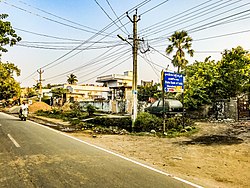Didugu
Didugu | |
|---|---|
Village | |
 Residential area in Dharanikota | |
 Dynamic map | |
| Coordinates: 16°20′43″N 80°10′33″E / 16.34527°N 80.17588°E | |
| Country | India |
| State | Andhra Pradesh |
| District | Palnadu |
| Mandal | Amaravathi |
| Government | |
| • Type | Panchayati raj |
| • Body | Didugu Gram Panchayat |
| Area | |
| • Total | 2,352 km2 (908 sq mi) |
| Population (2011)[3] | |
| • Total | 3,152 |
| • Density | 1.3/km2 (3.5/sq mi) |
| Languages | |
| • Official | Telugu |
| Time zone | UTC+5:30 (IST) |
| PIN | 522020 |
| Area code | +91–8640 |
| Vehicle registration | AP |
Didugu is a village in Palnadu district of the Indian state of Andhra Pradesh. It is located in Amaravathi mandal of Guntur revenue division.[2] The village forms a part of Andhra Pradesh Capital Region, under the jurisdiction of APCRDA.[4]
Geography[edit]
Didugu is situated to the west of the mandal headquarters, Amaravathi,[5] at 16°20′43″N 80°10′33″E / 16.34527°N 80.17588°E. It is spread over an area of 2,352 ha (5,810 acres).[2]
Demographics[edit]
As of 2011[update] Census of India, Didugu had a population of 3,152. The total population constitute, 1,580 males and 1,572 females with a sex ratio of 995 females per 1000 males. 336 children are in the age group of 0–6 years, with child sex ratio of 846 girls per 1000 boys. The average literacy rate stands at 53.69% with 1789 literates.[2]
Government and politics[edit]
Didugu Gram Panchayat is the local self-government of the village.[1] There are wards, each represented by an elected ward member. The present sarpanch is vacant, elected by the ward members.[6] The village is administered by the Amaravathi Mandal Parishad at the intermediate level of panchayat raj institutions.[5]
Education[edit]
As per the school information report for the academic year 2018–19, the village has a total of 2 schools. These schools include one MPP and one private school.[7]
References[edit]
- ^ a b "Gram Panchayat Identification Codes" (PDF). Saakshar Bharat Mission. National Informatics Centre. p. 95. Archived from the original (PDF) on 18 August 2017. Retrieved 7 May 2019.
- ^ a b c d "District Census Hand Book : Guntur (Part B)" (PDF). Census of India. Directorate of Census Operations, Andhra Pradesh. 2011. pp. 14, 252. Retrieved 1 June 2019.
- ^ "Population". Census of India. Registrar General and Census Commissioner of India. Retrieved 8 May 2019.
- ^ "Declaration of A.P. Capital Region" (PDF). Andhra Pradesh Capital Region Development Authority. Municipal Administration and Urban Development Department, Andhra Pradesh. 30 December 2014. p. 4. Archived (PDF) from the original on 11 May 2019. Retrieved 14 May 2019.
- ^ a b "District Census Handbook : Guntur (Part A)" (PDF). Census of India. Directorate of Census Operations, Andhra Pradesh. 2011. pp. 328–329. Retrieved 3 June 2019.
- ^ Mathew, George; Sciences, Institute of Social (1995). Status of Panchayati Raj in the States of India, 1994. Concept Publishing Company. pp. 19, 78. ISBN 9788170225539. Retrieved 31 May 2019.
- ^ "School Information". Commissionerate of School Education. Government of Andhra Pradesh. Archived from the original on 16 April 2019. Retrieved 7 May 2019.

